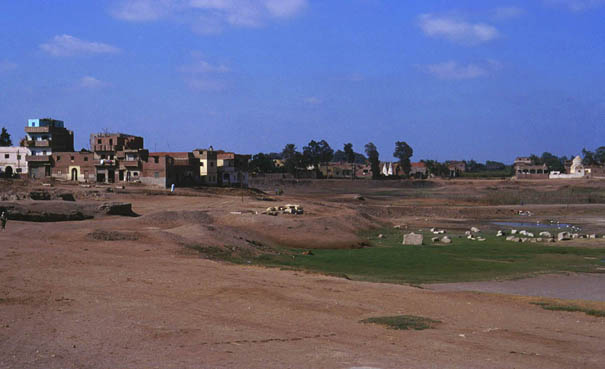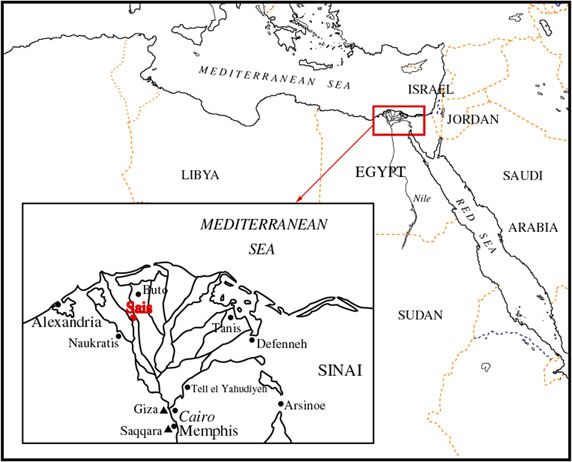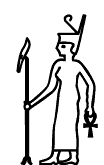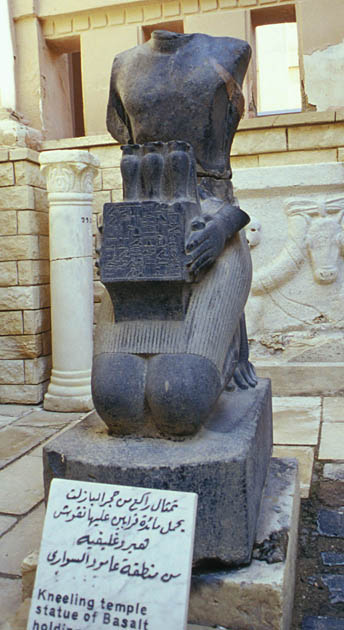Intro
Season Reports
The Royal City of Saïs

What is it ?
Sais is the Greek name for the Ancient Egyptian city ‘Sa’ . In hieroglyphs the name ‘Sa’ is written like this :

Where is it ?
The archaeological site of the city is in the western Egyptian delta (modern day Gharbiyah province). There is a village on the site called Sa el-Hagar, a name which combines the ancient name ‘Sa’ with the Arabic word for ‘stone’. It means ‘Sa the stone’ and is a good indication that there was once an impressive city here with many stone buildings.

What happened there ?
A five thousand year-old wooden label with the name of King Aha shows the symbol of Sais inside a wooden compound. Some Egyptologists think that this shows that Sais was an important cult centre in northern Egypt right at the very beginning of Egyptian history, around 3100 BC.

The cult emblem shows a shield-shaped object with two arrows crossed through it and is usually perched on a stand. The object may be a shield, or it could originally have been an animal skin hung up and used as target practice. It is the emblem of the goddess of Sais called Neith.
Which gods had cults at Sais ?

Neith (above) may originally have been a hunting goddess who could bring good hunting to hunters out in the the desert margins of the Western delta. She is usually depicted wearing a flat-topped crown with a coil element at the front and a tall projection at the back (below).

This was to become the Red Crown and symbolised all of Lower Egypt (the north). When Egypt was united into one kingdom, the Kings invented a crown combining the White Crown of Upper Egypt and the Red Crown of Lower Egypt.

Neith was a very powerful goddess and was also regarded as a creator. This is rare in Egypt because creation deities are usually male. She was, too, the mother of Sobek, the crocodile god associated with the fertility and power of the Nile. In the Late Period (from 1000 BC onwards), her temple was a centre of pilgrimage. It was famous for its linen cloth which is appropriate for this part of Egypt. Egyptian cloth was most often linen which is made from a plant called flax. This would grow very happily in the marshy, watery area of the Nile delta. The Neith temple had craftsmen and women who wove the cloth into very fine material, often almost see through. They had different grades of material, but the best was ‘royal’ cloth which was fine and transparent.
There were other important gods who had temples at Sais too.
Atum, another creator god, was associated with Neith. He was not really her consort, but more of a male-power counterpart.
Osiris was also popular at Sais. He was the Egyptian god of the dead who ruled over the spirits of those people reborn in the afterlife. He had a special form at Sais where he was called ‘Osiris Hemag’. The meaning of his surname is a bit mysterious, but seems to be something like ‘Osiris made of carnelian’ (a semi-precious stone, orange in colour). Usually Osiris was shown wrapped up like a mummy, but Osiris Hemag had bandages decorated with semi-precious stones. He would have looked spectacular — glistening, shimmering and gleaming in the afterlife sunlight. Many people came to make offerings to Osiris at Sais as an act of pilgrimage.
Were there any people at Sais ?
Sais was also a powerful political and economic centre. We do not know much about its role in Egypt’s early history, but in about 727 BC a man called Tefnakhte set himself up there as the ‘Great Chief of the West’ and claimed to rule the whole of the Western delta. This meant he would have controlled the agriculture in the area, the sea trade down the western branch of the Nile, the coast, the linen industry at Sais, the temple cults at Sais, the resources of the Wadi Natrun from where mummifying material came, and possibly the trade routes to the oases. The Oasis areas were especially famous for their wine, so Tefnakhte seems to have known what he was doing.
Was Tefnakhte a real king ?
Tefnakhte was really only a local ruler, but his descendants under Psamtek, who also came from Sais, eventually claimed to rule the whole of Egypt. This means that for 139 years Sais was the capital of this great civilization.
Who were these Saites ?
The Saite family had continuous problems with the Assyrians who eventually invaded Egypt, the Thebans who disliked being ruled by northerners but they had some help in the form of Greek mercenaries. These men were soldiers who were hired to guard important cities in Egypt such as Sais and also a trading city called Naukratis. They would also fight for their employers if necessary.
Many stories exist about the Saite kings but one of the most amazing things about them is that they were very interested in Egyptology! They wanted to show that they were worthy, true kings of Egypt and successors of their illustrious ancestors. Already by then the Pyramids at Giza were almost 2000 years old, so there was much to study. The Saite kings copied artistic styles and types of statue from the past so that they could demonstrate their devotion and piety. They commissioned many statues of themselves, restored temple buildings – an example followed by their officials — and most of all they made Sais one of the greatest cities in the known world. A Greek visitor called Herodotus was amazed by the size of the statues, the temples and the richness of the palaces he saw in the city.
What did the Saite kings do ?
Psamtek I

He may have been the first to used mercenary troops to defeat the other Egyptian princes. He sent his eldest daughter, Nitokris, to Thebes to be an important priestess there. This meant he had some influence in the south of Egypt, for she was an influential landholder. He reigned for 54 years, truly the founder of a dynasty.
Nekau

He sent a fleet of Phoenician ships to circumnavigate Africa and had a lot of problems with the Assyrians and the Medes (Persians). He reigned 15 years.
Psamtek II

Nefer-ib-ra P-sam-tek
He only reigned for 6 years, but was responsible for the construction of a huge number of monuments. He may have sent an expedition to Nubia, but was compelled to direct most of his attention to the wars to the north-east. He sent his daughter, Ankhnesneferibre, to Thebes to be the new ‘God’s Wife of Amun’ as successor to Nitokris.
Apries

He may have been deeply involved in the wars in Syria and over Jerusalem, but he definitely did send an army against the Greek colony of Cyrene (on the North African coast). The Egyptians were soundly beaten and Apries lost his throne. He reigned for 19 years.
Amasis

He took power after the failure of Apries who may have been murdered by the Saite mob. He made friendly overtures to other Mediterranean countries and made the Greek traders trade only from Naukratis, where they could be contained. He seems to have been very astute and was remembered well in Herodotus’ story of Amasis’ liking for Falernian wine. He ruled for 44 years.
Psamtek III

He was a bit unlucky as the Persians invaded Egypt in 525 BC just after he became king. After a great battle at Pelusium, the Egyptians retreated to Memphis where they surrendered after a siege.
We don’t know what happened to Sais then, but Cambyses, the Persian king, is said to have destroyed many Egyptian temples.
As Sais was the capital of the Saite kings they lived there and were also buried in tombs within the Neith Temple complex.
What happened after this ?
Sais continued to be the centre of a bishopric in the Christian period but by the 17th century had become a small village.
Why is it important ?
Egyptologists don’t know very much about the delta part of Egypt and about cities and how they were organised. They don’t like such gaps, so they go and try to fill them in. Manfred Bietak has been working hard in the Eastern delta for the last thirty years and has made some very important discoveries about ancient Egypt and its towns. There is still a gap in the west however.
We want to understand how cities could come to be important and the kind of factors which mean it was possible. We can understand some of the individuals who made things happen, such as Psamtek I and Amasis, but we would also like to know how the River Nile affected a city’s fortunes, how the Egyptian focus on the west may have influenced the eventual founding of Alexandria, how the city of Sais developed from 3000 BC onward as a cult centre, the way in which Sais worked as a pilgrimage centre, the types of industries and trading which happened there, how the royal obsession with the past affected ordinary people, the forms of Saite pottery, the shape and plans of the temples, the location of the city’s harbours, settlements, canals and so on.
My personal favourite quest is for the Sacred Lake at Sais. This Lake would have been a place where rituals were performed and also have provided water for washing in the temple. We know that the lake existed because Herodotus saw the ceremony of the lighted lamps performed on it, and also there is a statue of the man who built the lake. He gives us an indication of its exact size and location. It would be great to match up the accounts, the statue text and the archaeology!

What’s going on there now ?
The Egypt Exploration Society are sponsoring a survey and archaeological assessment of the site for future work. Visitors to Sais are often disappointed when they come to the site at the lack of things to see. However, as our work is showing, there is much to discover about Sais. Sometimes the visitor needs a good imagination and sometimes a lot of scientific help. But we believe the Royal City of Sais will begin to yield its secrets.
